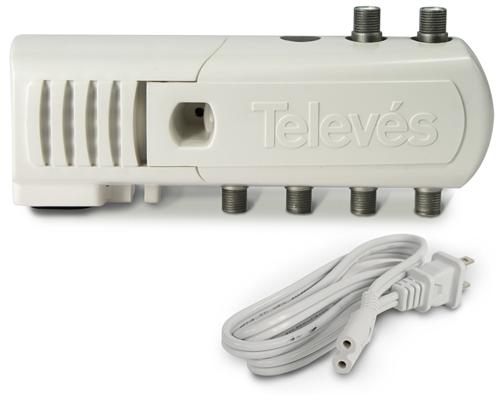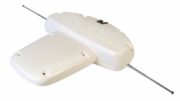What you see above you is a distribution amplifier. The purpose of a distribution amplifier is to give your antenna’s signal just a little bit more oomph. OK, actually about 200 times more oomph, but who’s counting. They come in all shapes and sizes and most importantly, all price ranges. The question you’re asking though, is whether or not you need one, or if an inexpensive, unamplified splitter is going to be good enough for you.
Do you need one?
For the most part, you don’t need a fancy distribution amplifier unless you are running a bar, restaurant, or some sort of other commercial building. Those places have cable runs in the hundreds of feet and they feed a lot of TVs at a time. For the most part if you are running three TVs that are less than 50 feet away, you don’t need one. There is a way to be sure and that’s to follow the formulas.
Do the math
The goal of a distribution amplifier, when you get right down to it, is to make up for the loss in the signal from being split. That loss is the combination of the loss from splitting (each split costs you 3dB of signal) as well as the “insertion loss” inherent in the splitter itself. (Insertion loss is the loss that happens as the signal goes into a new component.) Even a cheap splitter should have no more than 1-2dB insertion loss. In general, a 1×2 splitter will give you 4 dB loss, a 1×4 will give you 7dB loss, and a 1×8 will give you 14dB loss. These numbers vary a little from splitter to splitter but they’re pretty solid in general.
The other factor you need to account for is the cable length. You can use a calculator like this one, or if you’re in a rush you can figure that you’re going to lose 5dB per 100 feet, which is a pretty handy number and it’s not that far off in most circumstances. So let’s do the quick math:
Here’s a scenario
If you’re feeding 4 TVs and each is 50 feet away, then you’re losing 7dB from the splitter and 2.5dB from the line. Let’s round that up to an 11dB loss. That’s a lot, but it may not be a dealbreaker. Before putting in a distribution amplifier, see how the signal looks on the TV. TV signals can be detected at extremely low levels and if you have a larger antenna and are fairly close to the towers, losing that 11dB may not really hurt you. If you do choose a distribution amplifier, something in the 10-15dB range would be appropriate.
Will a distribution amplifier hurt you?
There is another factor, though… and that’s noise. Every component adds a small amount of noise and a cheap amplifier will add quite a lot of noise. Noise is much more important with digital signals, and it’s possible that a good signal can actually be made worse because of the noise added by an amplifier. That’s why you should really check the real-world performance of your antenna setup prior to putting in an amplifier.
What’s the best distribution amplifier?

In addition to the Televes unit at the top of this article, I’m partial to this Winegard Amplifier which gives 15dB performance, which is enough to overcome anything but a 1×8 splitter. Using this amplifier gives you the option of putting the smallest possible splitter on it.. A distribution amplifier with multiple outputs is designed to compensate for one very long run (which the one at the top of this article is.)
If you’re looking for a distribution amplifier or any other antenna technology, shop the great selection at Solid Signal.





